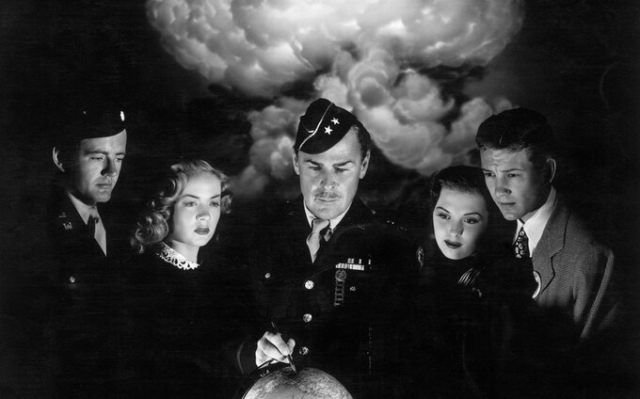 In the film Begin or End (1947), Brian Donlevy (center) stars as Major General Leslie Groves. Photo: Everett Collection Inc/Alamy Stock Photo
In the film Begin or End (1947), Brian Donlevy (center) stars as Major General Leslie Groves. Photo: Everett Collection Inc/Alamy Stock Photo
Christopher Nolan's Oppenheimer tells the story of how J. Robert Oppenheimer led a group of scientists from around the world to a newly built autonomous city in the New Mexico desert, where they worked feverishly to create the first atomic bomb. But The Manhattan Project was already on the big screen.
The first time Hollywood made an Oppenheimer film, it began as one scientist trying to sound the alarm about how dangerous a world with nuclear weapons might be, and turned into a piece of early Cold War propaganda in which almost everyone who claims to Scientists, the military, the American government, and even President Harry Truman himself intervened in the history of the Manhattan Project. «Begin or end» was supposed to be a warning; it turned into an attempt to make America stop worrying and love the bomb.
On October 28, 1945, a letter arrived at Donna Reed's home in Santa Monica from Dr. Ed Tompkins. Reid hoped he would write. She remembered Tompkins well—he was her high school chemistry teacher in Denison, Iowa, and loved his lessons. He was fun and interesting to be around, and he gave Reed a copy of How to Win Friends and Influence People, which did wonders for her confidence. She was now a movie star at MGM and had just landed the role of Mary Bailey opposite Jimmy Stewart in It's a Wonderful Life.
But a few years ago, all of a sudden, Tompkins stopped responding to her letters. She wondered why until she came across a newspaper article that said he was involved with the Manhattan Project in Oak Ridge, Tennessee. Now, at last, he could explain. And when Tompkins finally answered, he had an idea.
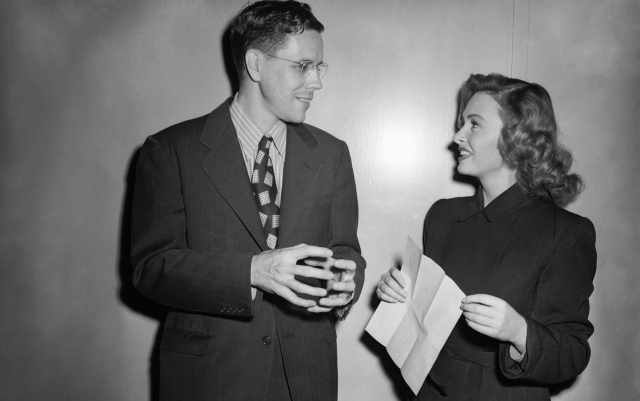 Donna Reed and Dr. Edward Tompkins, her high school teacher who also participated in the Manhattan Project. Image Credit & Copyright: Bettmann
Donna Reed and Dr. Edward Tompkins, her high school teacher who also participated in the Manhattan Project. Image Credit & Copyright: Bettmann
The letter, as shown in Greg Mitchell's story about the making of the movie Begin or End, was full of doom. According to Tompkins, there was «NO POSSIBILITY» for America to keep atomic secrets to itself. “A hundred long-range missiles with atomic explosives can destroy our civilization in a matter of minutes,” he wrote.
But he had an idea: «Do you think it is possible to plan and shoot a film to successfully instill in the public the horrors of atomic war?» He said the scientific community would help make sure this was an accurate picture of how America built the bomb and wanted to warn the world. «Could you help sell this idea to MGM?»
Reed's husband and agent Tony Owen and MGM producer Sam Marks were very interested, but there were many obstacles. The regulations in force at the time required real people to give their permission if they were portrayed in a film. This meant approval not only of Tompkins' old Los Alamos colleagues, but also of the military and government, including President Truman.
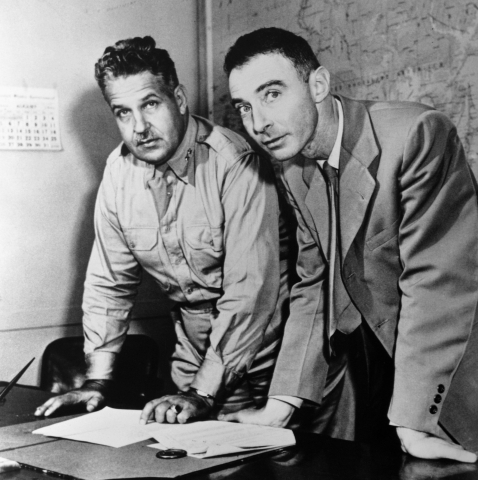 Leslie Groves and Oppenheimer in 1942 Photo: CORBIS/Corbis via Getty Images
Leslie Groves and Oppenheimer in 1942 Photo: CORBIS/Corbis via Getty Images
Eventually, Owen and Marks convinced nearly every stakeholder, including Enrico Fermi, Oppenheimer, and Manhattan Project CEO Leslie Groves (played by Matt Damon in Nolan's film). They managed to secure a 15-minute meeting with Truman in the Oval Office, where he allowed them to continue. As they were about to leave, Truman stopped them at the door.
«Make your film, gentlemen,» he told them. «And tell the world that in dealing with the atomic bomb we are either at the beginning or at the end.» Marks told Truman that he had just given them the title of their film.
Credibility was high and MGM's top management routinely described Begin or End as one of the most important films the studio had ever made. Early in writing, Tompkins added note after note to early drafts, objecting to scenes, dialogue, and characters that he felt were too far off the mark. In particular, he warned that Oppenheimer would never bless the script if he tried to pretend that he and Groves agreed with each other. “Oppenheimer will not allow himself to be portrayed as a “friend of the army,” which he certainly was not,” Tompkins said.
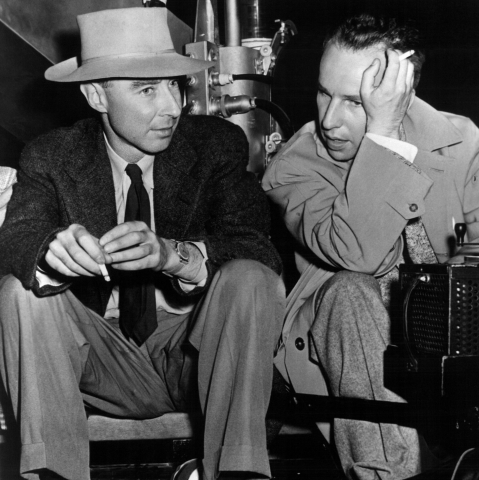 J. Robert Oppenheimer on set with Hume Cronyn, the actor who played him in Begin or End. Credit: Everett Collection Inc/Alamy Stock Photo
J. Robert Oppenheimer on set with Hume Cronyn, the actor who played him in Begin or End. Credit: Everett Collection Inc/Alamy Stock Photo
Meanwhile, another race for the bomb has unfolded at Paramount Studios. He also wanted to stage The Manhattan Project, and Casablanca producer Hal Wallis chose Ayn Rand to write the script. The Fountainhead just returned to the bestseller lists, and her previous film, Love Letters, was nominated for four Oscars. She saw the bomb as an opportunity to pay back, as she put it, «a tribute to free enterprise» by putting forward a cultural case against socialism that would make a «historic and immortal contribution» to human history.
She interviewed Oppenheimer and his wife Kitty before writing a 16-page treatment of the film, originally titled Top Secret. It ended with a very randish scene: a teenage boy watching the Manhattan Project roll out looks up at the night sky. “Now man is not like a worm in the face of the immensity of the universe,” read the appeal. «His figure looks heroic, the figure of a conqueror.»
Unfortunately for Rand, Wallis, in Mitchell's opinion, was «disappointed, if not appalled by her material,» and Top Secret was closed in mid-March 1946. MGM bought the Wallis film and received all of the material that Rand put together for it. Although she was angry, Rand interviewed Oppenheimer and molded them into the character of Robert Stadler, a government scientist involved in the mysterious Project X, in Atlanta Shrugged.
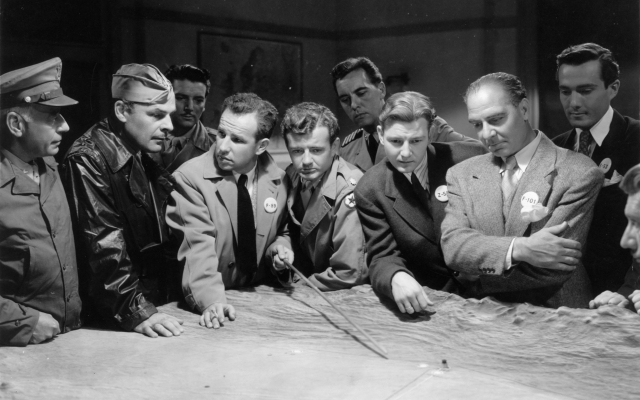 Leslie Groves (Brian Donlevy), J. Robert Oppenheimer (Hume Cronyn), Jeff Nixon (Robert Walker), Matt Cochran (Tom Drake) ) Enrico Fermi (Joseph Calleia) and John Wyatt (Heard Hatfield) in the 1947 film. Photo 12/Alamy Stock Photo
Leslie Groves (Brian Donlevy), J. Robert Oppenheimer (Hume Cronyn), Jeff Nixon (Robert Walker), Matt Cochran (Tom Drake) ) Enrico Fermi (Joseph Calleia) and John Wyatt (Heard Hatfield) in the 1947 film. Photo 12/Alamy Stock Photo
Tompkins' point of view was in keeping with the changing public mood. “Immediately after the bombing, and especially immediately after the end of the war, there is such enthusiasm,” says Dr. Alex Wellerstein, director of science and technology research at Stevens Institute of Technology and an expert on the history of nuclear weapons. «Like, 'Hooray, we're entering this new era, we've won the war and it's amazing what we're capable of.' And it was tinged with foreboding: what will this mean for the future?”
In late August 1946, John Hersey's report from Hiroshima took up almost the entire issue of the New Yorker. Through the stories of six survivors, he painted a harsh, horrifying picture of what a single bomb could do. From the west, the bomb looked like a triumph. Japan has seen unprecedented horrors: a destroyed city, melted eyeballs, human beings turned into carbon atoms.
«This is the first look at the victims of the bombings that people in the West, especially in the United States, see from their point of view,» says Wellerstein.
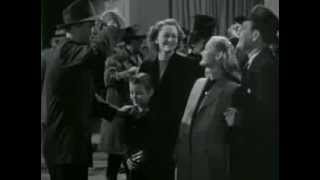
When the restrictions on information during the war disappeared, the bomb story was suddenly in the spotlight. According to Wellerstein, it was a «really powerful time» for a film that could convince the American public that its government was up to high moral standards.
When Tompkins wrote to Reed, he hoped the film would alert . America and the world to the true terror and responsibility that was in the hands of the country. But by the time it passed through the hands of General Groves, the meaning had changed.
In exchange for being the film's chief advisor, Groves convinced the producers to give him $10,000 and script approval. Groves took the opportunity to exalt his project and himself; Groves from the film are certainly suspiciously suave and winking. Early processing of the script required it to be «strong, beautiful».
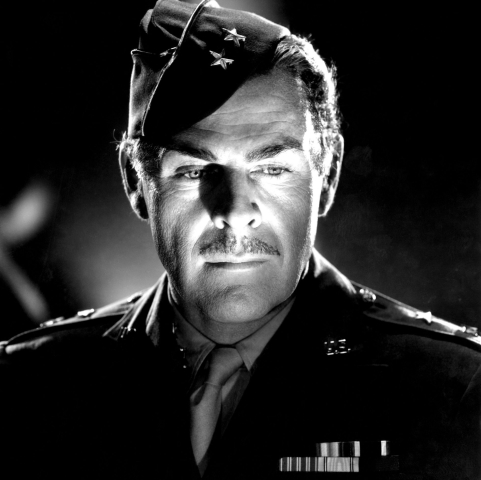 Brian Donlevy as Manhattan Project CEO Leslie Groves in the movie Begin or End. Photo: Everett Collection Inc/Alamy Stock Photo
Brian Donlevy as Manhattan Project CEO Leslie Groves in the movie Begin or End. Photo: Everett Collection Inc/Alamy Stock Photo
He sent me notes at every step of the scriptwriting process and touched on everything from the command structure at Los Alamos. and information about the bomb itself, down to seemingly insignificant details. By the last round of notes, he was objecting to an actor wearing a short, irregular length haircut and another male character wearing an apron.
This chance to shape public opinion really mattered to the military. In 1946 and 1947, bomb-dissenters in American politics came mainly from the right. Why, they asked, use this bomb to destroy cities when cities are perfectly destroyed by conventional weapons? The military was outraged. “They also oppose the idea that these scientists and engineers won the war, when in fact they won the war,” says Wellerstein.
Objections came from all sides. Lionel Barrymore, who co-starred with Reid as Mr. Potter in It's a Wonderful Life, filmed scenes as Franklin D. Roosevelt. But Roosevelt's widow Eleanor protested vehemently: Barrymore criticized her husband for many years and even organized a fundraiser against him. MGM backed off and the Barrymore scenes were re-shot with pro-democracy actor Godfrey Tearle.
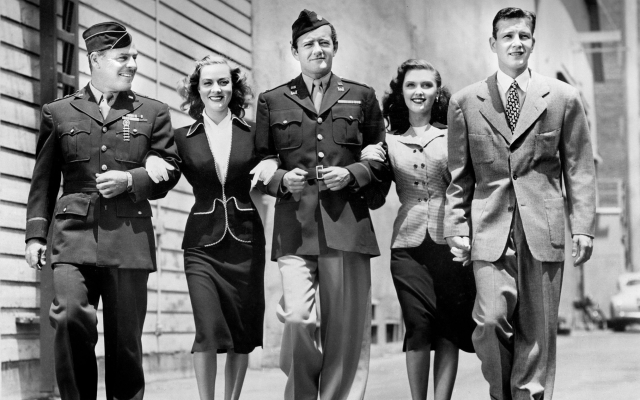 Brian Donlevy, Audrey Totter, Robert Walker, Beverly Tyler, Tom Drake in Begin or End. Credit: Glasshouse Images/Alamy Stock Photo
Brian Donlevy, Audrey Totter, Robert Walker, Beverly Tyler, Tom Drake in Begin or End. Credit: Glasshouse Images/Alamy Stock Photo
«It's a really interesting film because it stands out a bit,» agrees Dr. Christoph Laucht, an associate professor of history at Swansea University who has studied atomic age filmmaking. «He talks about building the atomic bomb and creates this whole story also about making decisions that never really happened that way.»
There are all sorts of fictional events in The Beginning and The End, but perhaps the most egregious are the speculations that America dropped leaflets in Hiroshima warning of an impending attack, and that the Enola Gay dropped a bomb while hit by flak, rather than flying through it. calm blue sky. To anyone who knew what really happened, it looked like an attempt to justify America's actions with a lie.
Then, after being screened in Washington by scientists, Truman's aides, and journalist Walter Lippmann on October 26, 1946, new recordings arrived—this time from the White House. Charles Ross, Truman's press secretary, wrote to MGM that he liked the film, but that «something needs to be done about the scene in which President Truman appears.» Ross said the president was too hasty to drop the bomb. MGM hit the ground running, writing a new scene in which Truman explained his opinion. This did not appease the Truman administration, who sent back their versions, adding lines like: «Thank God we have the bomb, not the Japanese!»
 Tom Drake played American scientist Matt Cochran in the film Begin or End. Credit: Everett Collection Inc/Alamy Stock Photo
Tom Drake played American scientist Matt Cochran in the film Begin or End. Credit: Everett Collection Inc/Alamy Stock Photo
MGM succumbed to censorship and interference, and according to Mitchell, that «almost certainly» extended to firing Roman Bonen. from the role of Truman. MGM told the White House it was looking for someone «physically fit, lively and alert…energetic and confident.» Character actor Art Baker was airdropped.
The facts have been twisted to suit the goals of the US government and the new priorities of the military, especially to justify dropping the bomb in the first place. “It was always built into the whole project,” Laucht says. “We will use this [bomb] because the costs are very high. How else can we justify it to the public?”
There are more serious problems in «Beginning» and «End». It's unbearable, mind-numbingly harsh. The setting is lifeless. For the most part, the most extraordinary and exciting scientific breakthrough comes through a lot of rather boring people sitting in rooms and explaining how division works. At one point, a scientist draws on a blackboard and explains nuclear chain reactions in folk terms—atoms split «like lightning striking a tree»—in the style of an informational movie for teens.
 A movie theater in Oak Ridge, the city founded for the Manhattan Project, shows Begin or End in 1947. Photo: Prisma by Dukas Presseagentur GmbH/Alamy Stock Photo The creators of Begin or End wanted this to happen. The film itself was a dead end. It opened on March 17, 947 and lost MGM $1.6 million, or about $28.8 million today. A preview to scientists held in Chicago in late January 1947 was meant to be a warning.
A movie theater in Oak Ridge, the city founded for the Manhattan Project, shows Begin or End in 1947. Photo: Prisma by Dukas Presseagentur GmbH/Alamy Stock Photo The creators of Begin or End wanted this to happen. The film itself was a dead end. It opened on March 17, 947 and lost MGM $1.6 million, or about $28.8 million today. A preview to scientists held in Chicago in late January 1947 was meant to be a warning.
The audience was unimpressed by the mood of the bomb and Groves supporters. Some sat in silent disappointment. Some felt angry. Some mocked. Leo Szilard, who took some time to get involved, was distressed. He slipped out of the display through a side door and hid in fellow scientist Harrison Brown's car until it was over. Brown found him pinned to the floor behind the front seats, trying not to be seen.
Mitchell later writes down Szilard's thoughts: «If our sin as scientists was to create and use the atomic bomb, then our punishment was to watch Begin or End.»



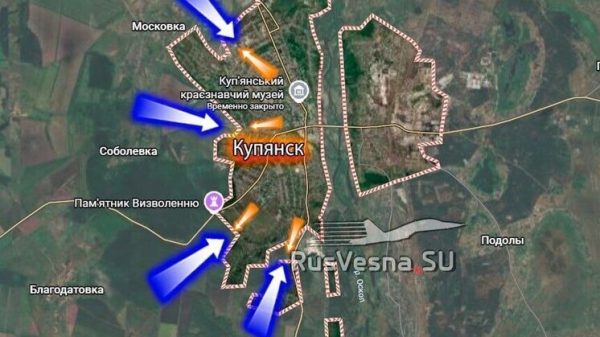










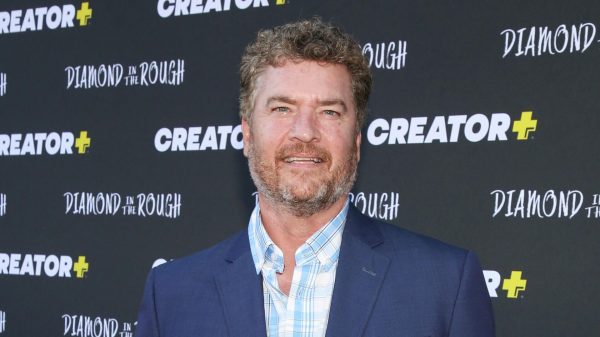



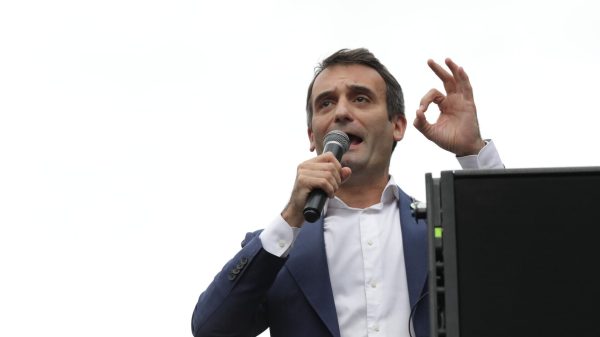
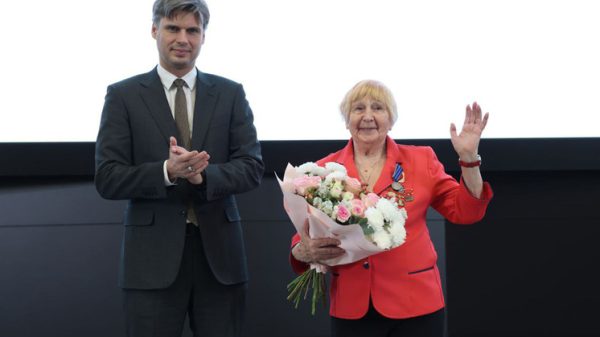

































Свежие комментарии